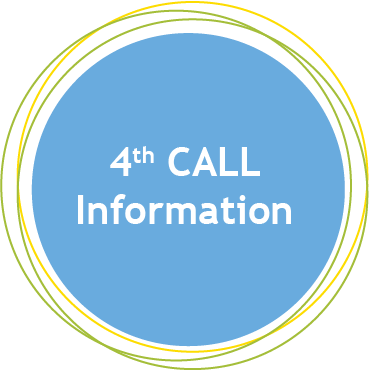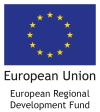This page was last updated on 09.10.2018
IMPORTANT 4th call information!
The application is filled in in the electronic Monitoring System (eMS). To insert the application form, the eMS is open between 15.10.2018 -16.11.2018. All applications must be submitted electronically by 15:00 (Finnish time, EET) on the closing date of the call. Please take the possible time difference into consideration when filling the application form.
We strongly encourage not to leave the submission to the last day.
4th call in more details
What is the 4th call going to fund?
What kind of projects are needed?
Timetable
Who can apply?
The application process
What’s next?
Getting started
What is the 4th call going to fund?

In total, at least 8m euros are available in four priorities. The exact amount of available funding is influenced by returning funds from implementing projects.The maximum ERDF rate is 79% on project level.
What kind of projects are needed?
Priority 1, SO 1.1. and SO 1.3. (€3,2m)
SO 1.1 New Central Baltic knowledge intensive companies
We would like to exploit different talents of Central Baltic countries for new business creation, by supporting the projects implemented by professional business development organizations which lead to the new joint Central Baltic companies and more co-operation between them. Successful project is likely to include complex activities combining the awareness raising, training, coaching, mentoring, incubation and accessing financing. Specific focus within specific objective is foreseen to address the challenges of sparsely populated, isolated archipelago and island areas where Programme supports also the development of new business directions of established companies.
SO 1.3 More exports by the Central Baltic companies to new markets
The Central Baltic programme wants to open the new markets outside of Europe for companies. This is achieved via cluster based co-operation. Based on established co-operation experiences (established clusters), we would like to see the projects of similar and complementary partners achieving sales on new targeted markets by Central Baltic SMEs. For achieving this, the programme supports projects which include complex new market entry activities that combine market research, product/service adaptation, capacity building, human resource development, active sales support activities, advisory services, participation in fairs and product presentations.
After three successful calls we are well on track in achieving results based on promises and good activity plans of approved projects.
Priority 2, SO 2.1 (€2,1m)
SO 2.1 Natural and cultural resources developed into sustainable tourist attractions
The aim of the specific objective is to develop existing cultural and natural resources into joint tourist attractions and products. There should be a balance between using and developing these resources and preserving them and their environment. Activities of the projects should also contribute to the attractiveness of living and visiting environment. Sustainable economic development should be a guiding principle in developing joint attractions. The programme will target sites of natural and cultural heritage that are joint for one of the sub-programmes of the Central Baltic Programme. There must be potential for developing the resource into a tourist attraction, and also for increasing the number of visitors to that attraction.Financed projects have been able to define resources and specific attractions that will be composed into a joint tourist attraction. The common thread(s) between the “pieces” of this joint attraction in different countries have been identified and will be used as strength(s) in developing the attraction. Projects have an innovative approach and positive environmental effects. Organisations represented in the partnerships are tourism development organisations, municipalities, universities etc.
A couple of good projects are still needed to fulfill the programme result indicators. Emphasis of the current projects is on cultural heritage, so project ideas targeting natural resources as potential joint tourist attractions are especially welcomed.
Priority 3, SO 3.1 (€1,8m)
SO 3.1 aim is to improve transport flows of people and goods.To meet the aim, the programme supports projects improving conditions in transport corridors and transport nodes. We support projects that promote the use of public transport, make the switch between different transport modes more comfortable, develop joint ticket systems and so on. In cargo transportation, the aim is to shorten the time goods move from producer to retailer or client. To achieve a shortened time, we support new solutions that eliminate bottlenecks of transport flows in different transport nodes and corridors.
Good and successful project ideas have identified operator-related problems and bottlenecks in transportation systems and provide solutions/improvements in cooperation with municipalities or regional authorities and transport organizations, involving end users.
Each project under this specific objective has to contribute to a result indicator, i.e. the decreased travel or transportation time as a result of the project has to be defined and demonstrated.
So far the programme has supported projects that develop innovative IT solutions for cargo movement and management on North-South corridor across the Finnish gulf and for smooth traffic regulation on Via Baltica, as well as development of new and more efficient sea routes in Stockholm and Åland archipelagos.
There are sufficient resources still available to finance several good projects and a number of transport corridors can be developed to make movement of people and goods more effective, saving time and reducing the negative impact on environment at the same time.
Priority 4, SO 4.1 (€1m)
SO 4.1 More people benefiting from stronger Central Baltic communities
The aim of specific objective 4.1 is to find solutions to the social inclusion problems that people living in the Programme area are experiencing, and provide practical “people to people” measures to improve the social inclusion of the selected target groups. The projects are contributing to the programme result indicator by implementing measures to increase the social inclusion of the communities in their selected target groups.For example, projects supporting the unemployed to access the labour market, preventing school drop-out, improving social inclusion of person with disabilities or any other groups at risk of social exclusion can be financed from the specific objective 4.1. The project partners can be different organisations working in the field of social inclusion: local municipalities, NGOs, education institutions.
Projects must be very practical and implement activities that support the social inclusion of the target group already during project implementation. It is important that members of the target group – the persons with social inclusion problem – would directly participate in the project activities.
It is advisable to describe the target group, which the project intends to work with, as precisely as possible and plan the activities to help that target group. The main aim of the project should be developing and implementing services for the target group, although the activities can involve some research, analysis or other supporting activities as well. Several current projects are using different training, counselling and group work methods that are adjusted to the target group’s needs. It is also important that the project describes, how the target group will be reached.
In order to fulfill the programme result indicator, project applications are still needed in the 4th calls. Projects targeting any of the above mentioned risk groups are eligible, especially welcome would be applications preventing the social exclusion and providing employment opportunities for minorities and immigrants. Only small projects are eligible under this specific objective.
The programme aims to fund at least one project in each opened Specific Objective.
Timetable
We encourage you to start developing your project idea right now (see getting started at the end of this text).The eMonitoring System (eMS), in which the application is filled in, is open between 15.10.2018-16.11.2018.
The Steering Committee takes the decision on 4th call projects in March 2019, thus making the first possible start date for projects 1 April 2019.
Projects have to end by 30 June 2021.
Who can apply?
A project partner can be a public authority (national, regional and local) as well as a body governed by public or private law. Only large companies are excluded from acting as partners. The detailed descriptions of partner eligibility can be found in the Programme Manual. The minimum number of partners in a project is two and they must be from two programme area countries.The application process
The application process in the 4th call is done in 1step for small and regular projects. This means that the applicant is expected to fill in the full application, meaning activity plan, budget, partnership and so on in the eMS immediately.Due to limited amount of available funding, we strongly encourage projects to consult the Joint Secretriat to ensure a good fit of the application to the programme and high quality of the project.
Getting started
Here are some tips and pointers to help you get started with your project idea- Read carefully the Guide for Filling in the Application Form (last updated on 7.2018) and the Programme Manual, (last updated on 8.2018). These two documents have been updated to reflect the 4th call.
- Review our Priorities and Specific Objectives
- See what kind of projects have been funded
- Check the application phase documents (http://centralbaltic.eu/document-categories/application-phase) and from there, especially the project idea form. We will inform about the updated guidance documents, once they become available.
- Our national Contact Points are happy to help you with finding relevant partners in other regions, and to provide you with information on the basic project requirements on programme level.
- If you need partners, the partner search notice board is also a good place to look at.
- Project managers and coordinators at the Joint Secretariat will help you with consultations related to project ideas and project contents as well as project eligibility on Priority and Specific Objective levels.


